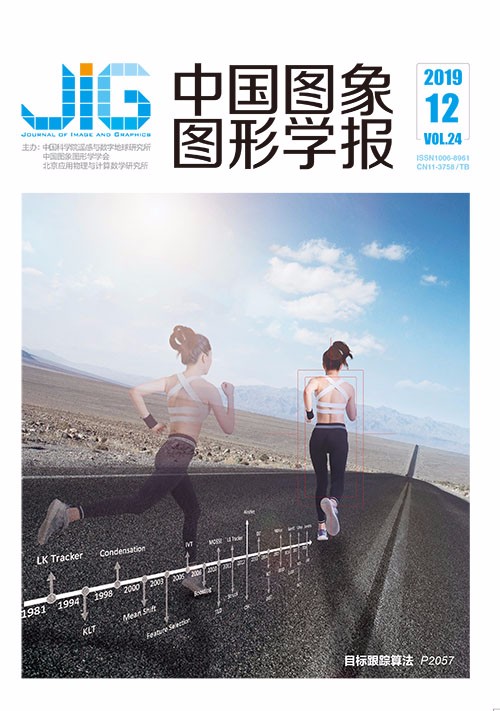
双特征模型核相关滤波目标跟踪算法
摘 要
目的 基于深度学习的目标跟踪算法,利用卷积深层作为特征,虽然精度高但无法做到实时跟踪;基于相关滤波的跟踪算法,利用HOG(histogram of oriented gridients)、CN(color name)和颜色直方图作为特征,速度快但精度较差。为兼顾目标跟踪算法的实时性与准确性,提出了一种基于双模型核相关滤波算法。方法 提出了自适应的双特征模型选择机制,主特征模型采用浅层纹理特征HOG,辅助特征模型采用包含深层语意信息的CNN(convolutional neural networks)特征,二者协同作用,产生更加稳定的相关滤波器。为了提高算法的速度,采用主成分分析(PCA)技术对高维的CNN特征进行降维,并通过尺度优化、最优解求解方式优化等方法提高跟踪算法的准确性。结果 在公开数据集OTB-2013上,本文算法与目前先进且速度能达到实时的SiamFC(fully-convolutional Siamese networks)、MEEM(multiple experts using entropy minimization)、SAMF(scale adaptive multiple features)、DSST(discriminative scale space tracking)等跟踪算法进行比较,一次成功率(OPE)结果显示,本文算法在距离精准度指标中综合排名第一,与KCF(kernel correlation filter)算法相比,本文算法的距离精准度提高了25.2%,重叠成功率提高了25.6%,平均速度达到38帧/s。结论 本文提出的双模型自适应机制,针对主特征模型的置信响应自适应调用最优模型策略,并且实时更新模型,在综合考虑跟踪准确性和跟踪实时性的情况下,本文提出的目标跟踪算法的性能优于目前的跟踪算法。
关键词
Kernel correlation filtering algorithm based on a dual-feature model
Meng Lu, Li Chengxin(College of Information Science and Engineering, Northeastern University, Shenyang 110004, China) Abstract
Objective The target tracking algorithm that is based on deep learning and uses deep convolution features is highly accurate, but it cannot be tracked in real time nor applied to actual situations. The deep convolutional features of convolutional neural networks (CNNs) contain advanced semantic information. Even when the target appearance model has serious interference, such as illumination variation, deformation, and other interference factors, the deep convolution features still exhibit an accurate discriminative performance in the target. Although the tracking algorithm based on correlation filtering is fast (up to several hundred frame/s), it is inaccurate. The algorithm uses the histogram of oriented gradient (HOG), color name (CN), and color histogram as statistical features to calculate the correlation of two image blocks. The position with the highest correlation is the predicted position. To balance the real-time tracking capability and accuracy of the target tracking algorithm, this study proposes a dual-model kernel correlation filtering algorithm based on the combination of the accuracy of the deep convolution feature algorithm and the speed of the correlation filtering algorithm. Method An adaptive dual-feature model selection mechanism is proposed. The dual model consists of main-and auxiliary-feature models. The main-feature model adopts a shallow texture feature. The dimension of the HOG feature is relatively low. Thus, it has a high calculation speed. The main-feature model is used for the real-time tracking of video sequences with clear texture contour features, and the kernel correlation function of the correlation filter of the main-feature model uses the Gaussian kernel function. The auxiliary-feature model employs CNN features containing deep semantic information. When serious interference factors, such as illumination variation, occlusion, and deformation, occur in video sequences, the auxiliary-feature model with deep CNN features is used to determine and correct the target position because such factors lead to low-confidence responses of the main-feature model. The linear kernel function is utilized by the kernel correlation function of the auxiliary feature model's correlation filter. The main-and auxiliary-feature models correspond to individual model update and synergistically cooperate to generate a stable correlation filter and improve the computational efficiency of the algorithm. The auxiliary-feature model adopts deep CNN features. The dimension of deep CNN features is too high, resulting in low calculation speed. To optimize the calculation speed and ensure the real-time performance of the algorithm, we use principal component analysis (PCA) to reduce the dimensionality of high-dimensional deep convolution features. Under the premise of saving as much effective information of the original features as possible, the dimension of the CNN features is reduced, and the computing speed is improved. This work also improves the accuracy of the tracking algorithm by optimizing the scale and the solution method. Result When the appearance model of the target changes seriously, the confidence response value of the main-feature model becomes too low. In this case, the dual-feature model discriminating mechanism promptly calls the auxiliary-feature model to correct the target positioning in real time. Experiments show that adopting the adaptive dual-feature model recognition mechanism is effective. We compare our algorithm with current advanced tracking algorithms with real-time speed, such as SiamFC(fully-convolutional Siamese networks), MEM(multiple experts using entropy minimization), SAMF(scale adaptive muttiple features), DSST(discriminative scale space tracking), KCF(kernel correlation filter) Struck, and TLD(tracking learning detection). The OPE result of the public dataset OTB-2013 shows that the proposed algorithm ranks first in terms of distance precision rate. Compared with the KCF algorithm, the distance precision and overlap success rates of the proposed algorithm are improved by 25.2% and 25.6%, respectively, and the average speed of the proposed algorithm can reach 38 frame/s. To demonstrate the performance of the proposed tracking algorithm more concretely, we also compare it with the most advanced tracking algorithms based on deep convolution characteristics, such as VITAL, SANet, and CCOT. However, these algorithms cannot meet the real-time performance requirement and cannot be applied in actual situations. Conclusion A new tracking model mechanism is proposed in this study. An auxiliary-feature model is added to the main-feature model. The auxiliary-feature model adjusts the optimal position of the target in real time according to the change in the confidence response of the main-feature model and prevents the main-feature model from drifting. PCA is introduced to reduce the dimensionality of the deep convolution feature and optimize the speed of the algorithm. However, the proposed algorithm still has problems. First, a change in the environment would lead to uncertainty of the auxiliary model's threshold. Setting the threshold of the mobilization auxiliary model to a fixed value would reduce the adaptability of the tracking algorithm. Second, the stability of the main-feature model's correlation filter directly affects the accuracy of the algorithm. The correlation filtering algorithm expands the sample set by introducing a sample period hypothesis, but the period hypothesis also introduces the boundary effect, which considerably reduces the accuracy of the filter. To improve the accuracy of the algorithm, methods to eliminate the boundary effect should be introduced. Examples of such methods include adding a spatial regularization term in the ridge regression solution or adding a mask matrix image to highlight the target position. The results of the OTB-2013 public dataset show that the performance of the proposed target tracking algorithm is better than that of current tracking algorithms in terms of tracking accuracy and real-time tracking. The proposed tracking algorithm has good adaptability under 10 different interference factors, such as motion blur, scale variation, and rotation.
Keywords
target tracking adaptive feature convolutional neural network (CNN) correlation filter principal component analysis (PCA)
|



 中国图象图形学报 │ 京ICP备05080539号-4 │ 本系统由
中国图象图形学报 │ 京ICP备05080539号-4 │ 本系统由